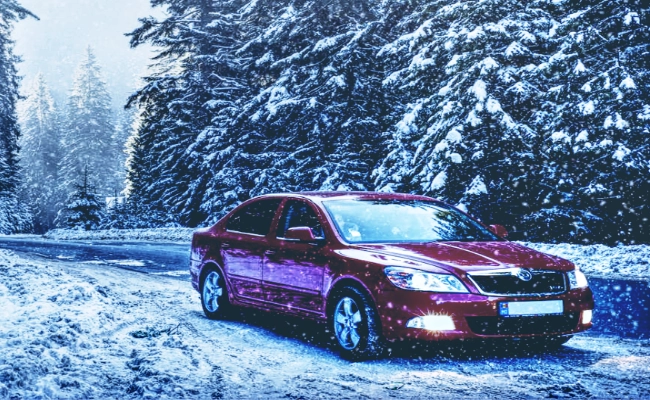Essential Winter Preparation: Prepare Your Vehicle for Cold Weather Conditions
Get ready to conquer winter roads with our comprehensive Winter Car Maintenance Checklist! As the temperatures drop, it's crucial to ensure your vehicle is prepared for the challenges of the season. From tire care and fluid checks to battery health and emergency preparedness, our checklist covers every essential aspect of winter car maintenance. Stay ahead of the cold weather with expert tips on heating and defrosting, driving safety, and preventive measures to protect your vehicle from winter elements. Whether you're a seasoned winter driver or facing your first snowy season, our checklist will guide you through the steps to keep your car running smoothly and safely. Don't let winter catch you off guard.

Winterising Your Vehicle: A Wise Decision for Safe and Smooth Driving
As the temperature drops and the first snowflakes fall, there is more than simply a change in the air. These frigid months present your car with a whole new set of obstacles. But don’t worry, we’ve got your back! This blog is your go-to resource for winterising your vehicle and ensuring a safe and stress-free driving experience.
Winter car preparation isn’t only about comfort; it’s also about safety and avoiding vehicle damage. Cold temperatures, snow, and ice may be hard on your vehicle, and if it isn’t properly equipped, you may experience problems ranging from engine trouble to poor visibility. However, with the proper preparation, your car can navigate the winter months as easily as a sledge on fresh snow. Let’s get started with the essentials of winter car care.
What Happens When You Don’t Prepare Your Car for Winter?
So you may be thinking, “I’ve skipped winter preparation before, and it wasn’t a big deal.” It’s kind of like playing Russian roulette with your car. You may get lucky at times, but you may also suffer terrible penalties. Let us discuss what could go wrong.
To begin with, your car is not invincible. Cold temperatures can be difficult for the components. For example, your battery could die early due to the cold, leaving you stranded on a chilly morning. In colder weather, your engine oil might thicken, making it more difficult to start and perhaps inflicting damage over time.
Let us now discuss tyres. Winter weather may make roads slick, and if your tyres are worn out or not designed for snow and ice, you risk losing traction. This can create dangerous conditions, making it much more difficult to maintain control of your car or stop in time to avoid an accident.
Another major issue in the winter is visibility. If your windscreen wipers aren’t in good repair or your defrosting systems aren’t working properly, your ability to see clearly will suffer. Poor vision combined with unpredictable winter weather can be perilous. Skipping winter automobile prep may appear to be a simple time saver, but it is a shortcut that may result in safety hazards and vehicle damage. It’s not worth the risk. Stay with us as we walk you through the actions you need to do to get your automobile ready for the cold weather.
Winter Car Maintenance Checklist: Getting Your Vehicle Ready for the Cold
Now that we’ve established why winter car preparation is critical, let’s get down to business. Here are some important actions to take to ensure your automobile is winter-ready:
- Checking and Replacing Car Fluids: Cold winter air is harsh on your vehicle’s fluids. Antifreeze, as the name implies, keeps your engine from freezing in cold weather. Check that your antifreeze levels are enough and that it is blended with water in the proper ratio. Your car’s engine oil is very important. Cold weather can cause the oil to thicken, making it difficult to start your engine. Check your oil levels on a regular basis and consider upgrading to winter-grade oil if you reside in very cold climates.
- Tyre Care and the Option of Winter Tyres: Because your tyres are the only portion of your vehicle that comes into touch with the icy road, their upkeep is critical. Make sure your tyres are adequately filled, as tyre pressure might drop as the temperature rises. If you reside in a snowy environment, consider upgrading to winter tyres. These tyres have specific tread patterns that provide improved traction on snow and ice, allowing you to maintain control of your car.
- Battery Examination: The cold weather can be tough on your car’s battery. Low temperatures delay the chemical process inside the battery, resulting in a reduction in power production. Check your battery to verify it is in good working order and can withstand the chill. If the battery is old or weak, consider replacing it to avoid the dreaded “click, click, no start” on a frosty morning.
- Windscreen and Wiper Maintenance: Winter generally means less visibility. Keeping your windscreen and wipers in good working order is critical for clear vision. Replace damaged wiper blades and fill your windscreen washer reservoir with a freezing-resistant fluid. Check that your defrosting system is working properly to prevent fogging on the inside of your windscreen.
By following these key winter car maintenance tasks, you can help guarantee that your vehicle is ready to face the winter months safely and effectively. Following that, we’ll go over how to put together a winter roadside emergency kit. Keep an eye out!
Preparing an Emergency Roadside Kit for Winter: Be Prepared for Whatever Jack Frost Has in Store for You
Winter can still throw curveballs even with the finest preparation. That’s why it’s a good idea to have a cold-weather emergency roadside kit on hand. Consider it your personal winter survival kit. Don’t know what to include? We’ve got your back.
Let’s start with the fundamentals. A blanket, as well as warm clothing items such as gloves, caps, and thermal socks, are essential. If your car breaks down or you become stranded, these items will keep you warm while you await assistance.
A torch (with extra batteries!) is also essential. Winter days are short, and if you find yourself in a bind, you may find yourself in the dark. A torch can also be used to signal for assistance or to make repairs.
Now for the food. Bring some non-perishable food and drink with you. Granola bars, almonds, and dried fruit are all excellent choices. They may not be a gourmet supper, but they will keep you going if you are stranded for an extended period of time. Don’t forget to bring a manual.
A first-aid kit, a portable phone charger, jumper cables, and a bag of sand or cat litter (excellent for producing grip if your tyres become stuck in snow) are also useful items to have on hand. You’ll also need an ice scraper and a snow brush to keep your windows clear.
Remember, these are only the fundamentals. Customise your equipment to your unique demands as well as the normal winter circumstances in your location. You’ll be prepared for whatever winter throws at you if you have a well-stocked emergency roadside kit. In the following part, we’ll go over some winter driving safety advice. Stay warm and stay tuned!
Winter Driving Tips: How to Safely Navigate Jack Frost’s Playground
Driving in the winter is a very different experience than driving in other seasons. Even the most experienced driver can become apprehensive due to slick roads, poor visibility, and frigid temperatures. But don’t worry, with the appropriate information and a little patience, you can safely navigate the roadways. Here’s how it’s done:
First and foremost, calm down! This cannot be emphasised enough. Driving too fast on icy or snowy roads is a formula for disaster. The slick surface diminishes your vehicle’s grip, making steering and stopping more difficult. Even if it is slower than the posted limit, always drive at a speed that allows you to maintain control of your car.
Next, keep a safe distance from the vehicle in front of you. In icy circumstances, stopping distances can be up to ten times longer, so leave yourself plenty of room to stop safely. When it comes to driving, smooth and steady is the way to go. Sharp twists and abrupt braking should be avoided since they can cause your vehicle to slide.
Finally, always have a strategy. Check the weather before you travel, and if possible, avoid driving in bad weather. If you must go out, notify someone of your route and expected arrival time.
Remember that driving in cold conditions is about more than simply getting from point A to point B; it is also about doing so safely. Take your time, be prepared, and be mindful of the circumstances. Following that, we’ll look at some extra features your automobile might have to help you out over the winter. Stay tuned, and be cautious!
Conclusion: Is Your Car Prepared for Winter?
As we’ve seen throughout this blog, winter car preparation isn’t a luxury; it’s a requirement. The winter season’s frigid temperatures, slick roads, and reduced visibility can all pose major difficulties to your car and driving ability.
We’ve talked about how important it is to check and change your car fluids, maintain your tyres (and consider using winter tyres), make sure your battery is in good working order, and take good care of your windscreen and wipers.
In addition, we’ve emphasised the importance of having a winter-specific emergency roadside kit, which should include essentials such as a blanket, torch, and food/water. We’ve also offered some important suggestions for winter driving safety, emphasising the necessity of patience, preparation, and respect for the conditions.
Winter will undoubtedly create obstacles, but with good planning and a proactive attitude, these can be efficiently controlled. So, don’t wait for the first snowfall or for the temperature to dip below freezing to begin prepping your vehicle for winter.
Now is the moment to make sure your car is winter-ready. Regular maintenance and inspections, as well as safer driving habits and having an emergency kit on hand, can make a big difference. These procedures will not only help protect your car, but they will also contribute considerably to your safety and the safety of other road users.
Remember that staying ahead of winter is the best way to deal with it. So, let us enter the new season prepared and confident. After all, winter is simply a season, not a hindrance!
Spread the Winter Preparation Joy!
We hope you found this blog to be interesting and useful. Winter car preparation affects us all, so why not spread the love? Share this information with your friends, family, and fellow road users to ensure everyone is prepared for winter driving.
Do you have any winter automobile preparation recommendations of your own? We’d be delighted to hear them! Leave a comment and share your knowledge with our community. We can make winter driving safer and more enjoyable for everyone if we work together.
Remember, if you need help with your winter car preparations, please visit www.fullthrottlemaps.co.uk. We can check your fluids, change your tyres, or perform general maintenance on your vehicle. In addition, as a thank you for reading this article, we’re offering a special 20% discount on all of our services when you mention this blog’s title.
So don’t put it off any longer. Get your car winter-ready today and enjoy a safer, smoother drive throughout the winter. We hope to hear from you soon!

